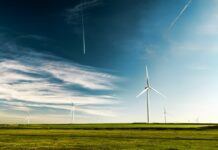The wind is a horizontally moving stream of air above the earth’s surface. The difference in atmospheric pressure causes this air movement. The larger the disparity, the faster the wind would be. The wind has been the driving force behind the turbines that turn its energy into electricity since the end of the 19th century.
Wind energy has been used for a long time; it was used to pump water, improve fields, and set sails in motion in ancient times. The first wind turbine to generate electricity was not the same as we know it today.
And when the wind isn’t blowing too strongly, today’s ones are much larger and generate more energy. Devices with twice the power of wind turbines currently installed in Europe and a span twice the length of a football field are currently being created.
How Does Wind Energy Work?
The wind is a weather phenomenon characterized by the passage of air. It caused by changes in temperature, pressure variations, or terrain peculiarities. The wind’s power influences more than just the movement of sailboats on the shore. It is also used in the production of electricity. Electricity is produced by wind turbines.
- HAWT (horizontal axis of rotation) and VAWT (vertical axis of rotation) are the two major types of turbines.
- HAWTs resemble conventional windmills in appearance, are very powerful at high wind speeds, and are much less expensive than vertical axis turbines.
- VAWTs are devices with futuristic shapes that enable the turbine to work regardless of wind direction changes.
They are more likely to make better use of the blast’s impact, but they must be incredibly tough to withstand the forces at work. As a result, they are significantly more costly than HAWT turbines.
Every turbine, whether small or big, vertical or horizontal, has the same basic components. These are: The tower, nacelle with the generator, and rotor with blades
How To Use Wind Energy?
Wind energy development is an opportunity that will pay off in terms of both reputation and industry for entrepreneurs. The organization can forecast its operating costs more accurately, in the long run, thanks to the consistent, secure price of generating electricity from a wind farm. In their image strategy, several entrepreneurs consider environmental sustainability priorities.
Wind energy is a practical way to minimize carbon emissions, raise brand awareness, and reinforce the company’s leadership position in the battle against climate change. Using renewable energy to power your business improves your company’s appeal to staff, clients, and investors.
Advantages Of Wind Energy
Using wind energy has many benefits. To begin with, it is self-evident that it is a clean and inexhaustible source of energy that produces no emissions or waste after use. By switching from conventional energy sources to “green” energy, we will reduce CO2 emissions into the atmosphere.
Although wind farms need a lot of lands and windy conditions to be effective, they can be constructed on even the most difficult ground and areas – water is a good example. It’s worth noting that offshore wind turbines are much more powerful than onshore wind turbines in this regard.
Rooftops of buildings are another choice for areas that aren’t obvious for windmills. Vertical wind turbines (VAWT) are more commonly installed on them. Because they take much less room to function than their horizontal counterparts.
For the investor, owning a wind farm is mainly an opportunity to achieve energy independence, avoid rising power costs, and use a personal source of free energy. In the case of businesses, it is often an opportunity to affect a brand’s or company’s positive image. Environmental activities are becoming increasingly relevant.








